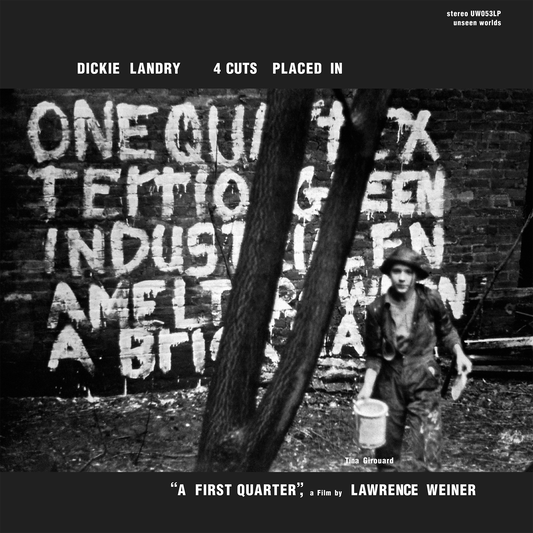On June 28, 1965, in Englewood Cliffs, New Jersey at the famed Rudy Van Gelder Studios, saxophonist John Coltrane convened his working quartet augmented by two trumpets, two alto saxophonists, two tenor saxophonists, and a second bassist to record an orchestral piece called Ascension. It was done in two complete takes, with rich polytonal collective improvisations separating each musician's solos. Coltrane chose a number of young musicians then beginning to make waves in New York's improvised music underground-saxophonists Pharoah Sanders, Archie Shepp, Marion Brown, and John Tchicai; trumpeter Dewey Johnson-along with semi-regular confreres Art Davis (bass) and Freddie Hubbard (trumpet) in addition to his unit with pianist McCoy Tyner, bassist Jimmy Garrison, and drummer Elvin Jones. Ascension wasn't the first large ensemble jazz record to use collective improvisation and soli as its blueprint – Ornette Coleman's landmark octet Free Jazz preceded it by five years, and Sun Ra was taking his Arkestra in vast new directions as well – but Coltrane was a hugely popular saxophonist with a major label recording contract, and this album was a polarizing line of demarcation in his career.
Just shy of seven years later, on February 19, 1972, a crew of mostly Louisiana-raised musicians came together at the Leo Castelli Gallery on West Broadway in Soho to perform a wholly improvised concert. Not unlike Ascension, this ensemble's solos spring from collective improvisations and a tumultuous backbeat, loosely inspired by the creations of Coltrane, Coleman, Albert Ayler, and their brethren. The de facto leader was Richard "Dickie" Landry, a saxophonist and keyboardist who was crucial in helping assemble The Philip Glass Ensemble in 1969, shifting its focus from Downtown cognoscenti to an intense crew of mostly Cajun musicians. For this recording, fellow Glass reedists Jon Smith and Richard Peck joined in alongside Rusty Gilder and Robert Prado, both doubling on bass (upright and electric) and trumpet. The drum chair was occupied by New Orleans firecracker David Lee, Jr., who brought alto saxophonist Alan Braufman along for the session (Braufman was the only non-Louisiana player in the band). The ensemble stretched out in the gallery for several hours in a configuration reflecting those that look place at Landry's Chinatown loft, documented in photos by artists Tina Girouard (Landry's then-partner) and Suzanne Harris that adorn the inside of the original gatefold album jacket. Recorded live by Glass' sound engineer Kurt Munkacsi, the album was released as a double LP on Chatham Square, the small imprint Landry and Glass co-ran, in a stark greyscale cover and simply titled Solos. The order of the players' improvisations was laid out on the album inner labels, though unsurprisingly there's a fair amount of blend.
Landry's history in music and visual art has been well-documented elsewhere, notably in my liner notes to Fifteen Saxophones (UW06/Northern Light 87003/Wergo 1019), but it's worth recounting that he became a fixture in downtown New York's loft and art scenes at the close of the 1960s after he and Girouard high-tailed it by car from Louisiana to the Lower East Side, auspiciously encountering Ornette Coleman at the Village Gate the night of their arrival: "Once [Tina and I got into town we stopped at Smith's Bar & Grill at Second Ave. and 13th St. to have something to eat and make a phone call. When we got back to the car everything was gone. Welcome to New York! Saxophone, clothes, everything – stolen. I found a hotel; the Village Gate was around the corner, and I saw that Ornette Coleman was performing that evening. We walked in and there was Ornette, so I immediately started talking to him. After a while he said, 'your accent-where you from?' I told him Lafayette. He said, 'Oh, I got beat up in that town once' and I told him my story of getting robbed. He didn't hesitate to give me his number and told me to call him if I needed a saxophone or anything else while in the city. We became friends right after that."
Landry was born in November 1938 in Cecilia, Louisiana, and grew up on a farm that he still owns and works regularly (he returned to the region in 1981). A jazz fanatic and woodwind player from childhood, he began visiting New York at age eighteen, meanwhile studying classical flute with Arthur Lora and playing in swamp pop bands back home. Coltrane was certainly a massive inspiration; in a recent conversation Landry recalled that he saw the saxophonist play in the Village: "it was a small club, crowded, I was up against the wall and he had to go through the crowd to get to the bandstand. He played an hour and twenty minutes, a whole set, at a furious tempo. Didn't give anybody else a solo, walked off the stage, walked by me and I kinda backed up – he was sweating profusely – and I said 'you sounded great, John.' He said 'thank you, man.' To this day I wonder why I didn't ask him any questions."
Introduced to Glass by inter-media artist and fellow Cajun Keith Sonnier, who was the focal point for many Louisiana-New York connections at the time, Landry quickly fell in with influential visual artists like Richard Serra, Chuck Close, Gordon Matta-Clark, and Robert Rauschenberg. As he put it in an interview for Paris Transatlantic Magazine in 2010, "I went in feet first-luckily I wasn't in jail, so I did whatever it took to make it work. I'd help Gordon Matta-Clark cut buildings, look photographs, did plumbing, construction, whatever I had to do in order not to go back to Louisiana. I was working with artists shooting photos of their works and doing physical labor building their pieces." After his first year in New York, Landry's colleagues started arriving from Louisiana to join the fray and the scene was set: "my friends decided that they should look into moving to New York. The first one to come was Robert Prado. I introduced him and Philip at a rehearsal and he was immediately hired. Then I brought saxophonist Richard Peck up, followed by Rusty Gilder, Jon Smith and Steve Chambers. Out of six musicians in the Philip Glass Ensemble, four of us were from Louisiana. I know we had a huge impact on that music." As Peck recounts, "I had an invitation to go to New York with Dickie and Tina in 1969 but for some reason I didn't do it, and then in '71 I moved up there and lived with them on Chatham Square. That was my beginning in New York. Hanging around Dickie and Tina's place was like a salon, you know-Dickie had a great record collection, and they were into things more deeply. Tina was an artist as well and it was an inspiring situation, but the focus was on the music. I had always wanted to go to New York, always heard about it. When Dickie came home he said, 'yeah man, I saw Charles Lloyd eating a hot dog on Broadway,' and it just stoked my interest. I loved New York from the very beginning."
There's a fair amount to unpack in the context surrounding Solos, but the environment that produced it is one that likely will never happen again, connected as it was to a specific post-minimal Downtown art and music scene. David Lee Jr. was the only Black player in the group; he had worked with players like saxophonist Sonny Rollins and keyboardist Joe Zawinul prior to appearing on Solos. While Braufman was a mainstay in New York's loft-jazz avant-garde, the remainder of the Solos were taken by members of Glass's ensemble, which was wedded in part to the gallery scene and bridged experimental rock and concert music. In addition, Richard Peck was and is a visual artist, while Landry has exhibited extensively as a photographer, painter, and installation artist. Both Landry and Peck were also involved with FOOD, an artist-run eatery in Soho conceived by Matta-Clark, dancer Caroline Goodden, and Girouard. New Orleanian Prado (who died in an oil field accident in 1974) played in jazz groups back in Louisiana, leading his own trio until moving east and working with Landry, Glass, saxophonist Charlie Rouse, and composer-arranger William Fischer. A trumpeter with Glass, Rusty Gilder also played bass with Duke Ellington and pianist Mose Allison, while Jon Smith cut his teeth with bluesman Edgar Winter's While Trash and was an in-demand studio musician.
Yet Solos is an altogether different affair than what Landry and company were doing with Glass, Fischer, or the soul•jazz and R&B-inspired sounds of swamp pop. It is a record that firmly fits in the free jazz camp-a black sheep among recordings of repetition-heavy electronic music or sound art in the Chatham Square catalog. Landry says that "it was the byproduct of the musicians who were jamming and living with me at 10 Chatham Square. Chatham Square is in Chinatown right at the end of the Bowery. We had two floors of a run-down, old tinderbox wooden building. I cooked a lot so it was a meeting place for artists and musicians [as was FOOD]. Munkacsi, Peck, Prado, and Philip all lived there at some point and it was also our rehearsal studio. Philip and I started a record label named after it, and we released several records. Anyway, we jammed free in the loft from 10pm until 6am. When Castelli offered me a concert, I went back to the loft and told the guys, 'we've got a concert.' They asked 'what are we going to do?' and I said, 'well, we'll do what we always do-we're just gonna start playing.' That's the way I liked to work, just turn the tape on. I am really not a jazz musician, though I do know how to improvise freely. The problem with Ibis is that it might work and then it might not. Munkacsi was working for John Lennon at the time so he borrowed Lennon's 16-track mobile studio, backed it up to the gallery and recorded our five-hour concert." The date itself was auspicious, chosen because it was Landry's daughter's eighth birthday.
Solos starts in medias res with both basses, Landry's electric piano, and drums thwacking in the gallery as the saxophonists keen en masse. Munkacsi related to Wire interviewer Tommy McCutchon in 2018 that "we brought the truck to Leo Castelli, parked it behind the gallery, ran the cables upstairs, and also had mic boxes that went upstairs. We set up all the mies and everything. [There was no] video in those days, so we had a talk-back system. I said, 'okay, recording' and they started playing." Or, more accurately, they hit right as Munkacsi began rolling, giving the record a feet-first sound, as though one had stepped into the loft as the group was at full tilt. Peck cements the energetic air around the session, saying that "one of the real important people in that situation was David Lee, the drummer. There was a lot of excitement around getting to play with him ... Jon Smith, he's got one of the most unique sounds on the saxophone that I've heard, bar none, of anybody. [He has] a lot of power and he played with Toto, Edgar Winter's White Trash ... he was in and out of New York at that time."
Introducing the first side, Lee's rhythm is an allover canvas, limber and dry but rich, while the plastic weave of amplified basses and sparse electric piano supports Smith's incisive tenor squall and Peck's more languid, flinty display. Braufman's exuberant, hoarse sear erupts and re-erupts, glinting off collective mass, audibly encouraged by background "yeah!"-s and rugged area interjections. It's curious that Landry begins the proceedings on keyboard, though his needling motivic fragments act as a subtle, spacey guide to keep the horns from going loo far afield, later switching to soprano as the players move into terse and brushy interplay. By the close of side three, which starts off with the confident, boppish swagger of Prado's trumpet against fragments of funk intermediated by lilting tenor, Lee enters into a skull-cracking, declamatory beat. Focusing on the drums is important-not only because of the New Orleanian's rhythmic centrality and intense forward motion, but also as the entire LP set is dedicated to Bobby Ramirez, the White Trash and La Croix drummer who was murdered in July 1972 at the age of twenty-three, mere months after Solos was waxed. For Landry and his companions Ramirez and his rhythmic focus "was the thing that inspired pulling Solos together-all I needed was a good drummer, which I had in David Lee Jr..”
For the final section of the second record, a contrabass and trumpet rendition of Coleman's "Lonely Woman" appears as the full band gradually settles into a rollicking close, Landry's nasal soprano bounce and Lee's toms echoing a Pibroch call with horns and basses droning underneath, in homage to sonic forebears. It's curious that as a recording as well as an event, Solos never made its way into the pantheon of 1970s loft jazz dates alongside works by fellow saxophonists Sam Rivers, Dave Liebman, or even Braufman's own Valley of Search LP (released on India Navigation in 1974, reissued in 2018). That's partly because of the fact that most of the musicians present worked outside of the avant-garde jazz realm, with Landry and Peck particularly busy in Glass' productions. Landry's coyness about playing jazz or free improvisation is somewhat surprising too, given the steady and concise creative blowing that's on offer here. With the convergence of interest in 1970s New York and all its artistic guises, now is the time to get this music into the hands of a new audience. At the end of the day Solos is beyond category, a rousing exploration of instrumentation, rhythm, and life.
Clifford Allen
Brooklyn, NY
November 2020
*David Lee, Jr. died in August 2021 at the age of 80 in his hometown of New Orleans, LA.
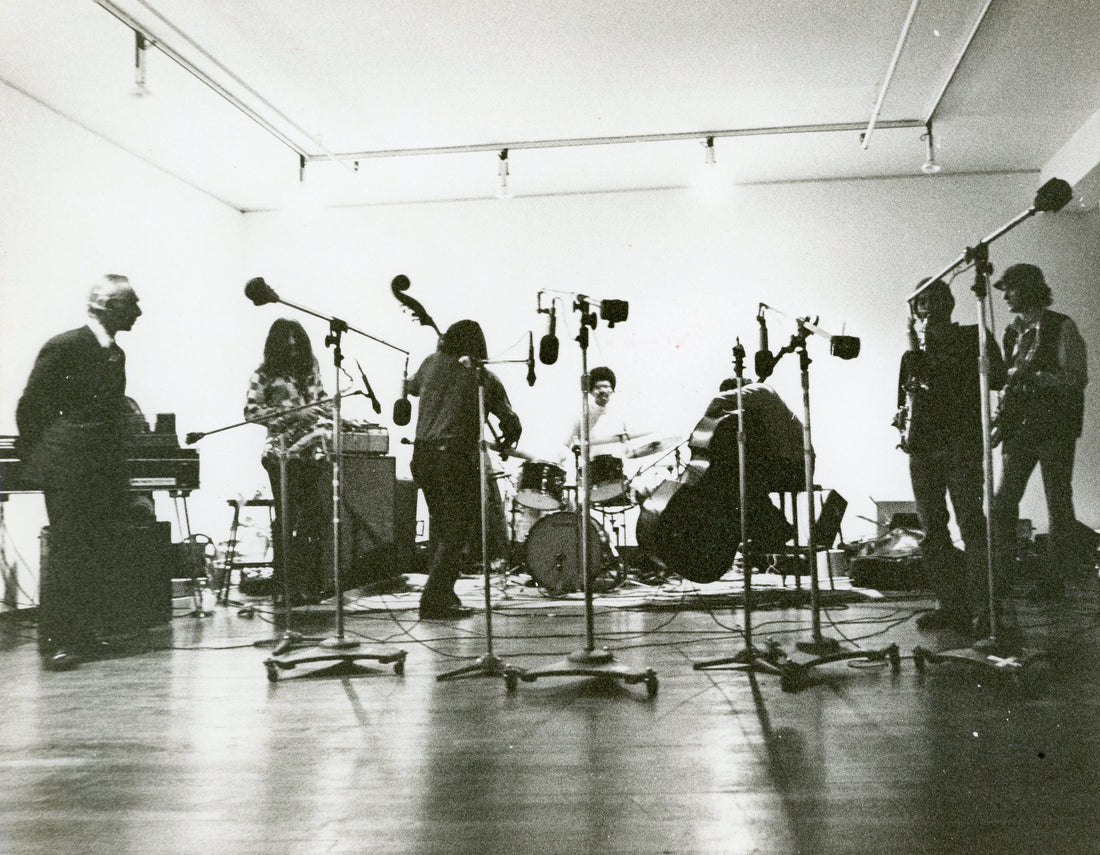
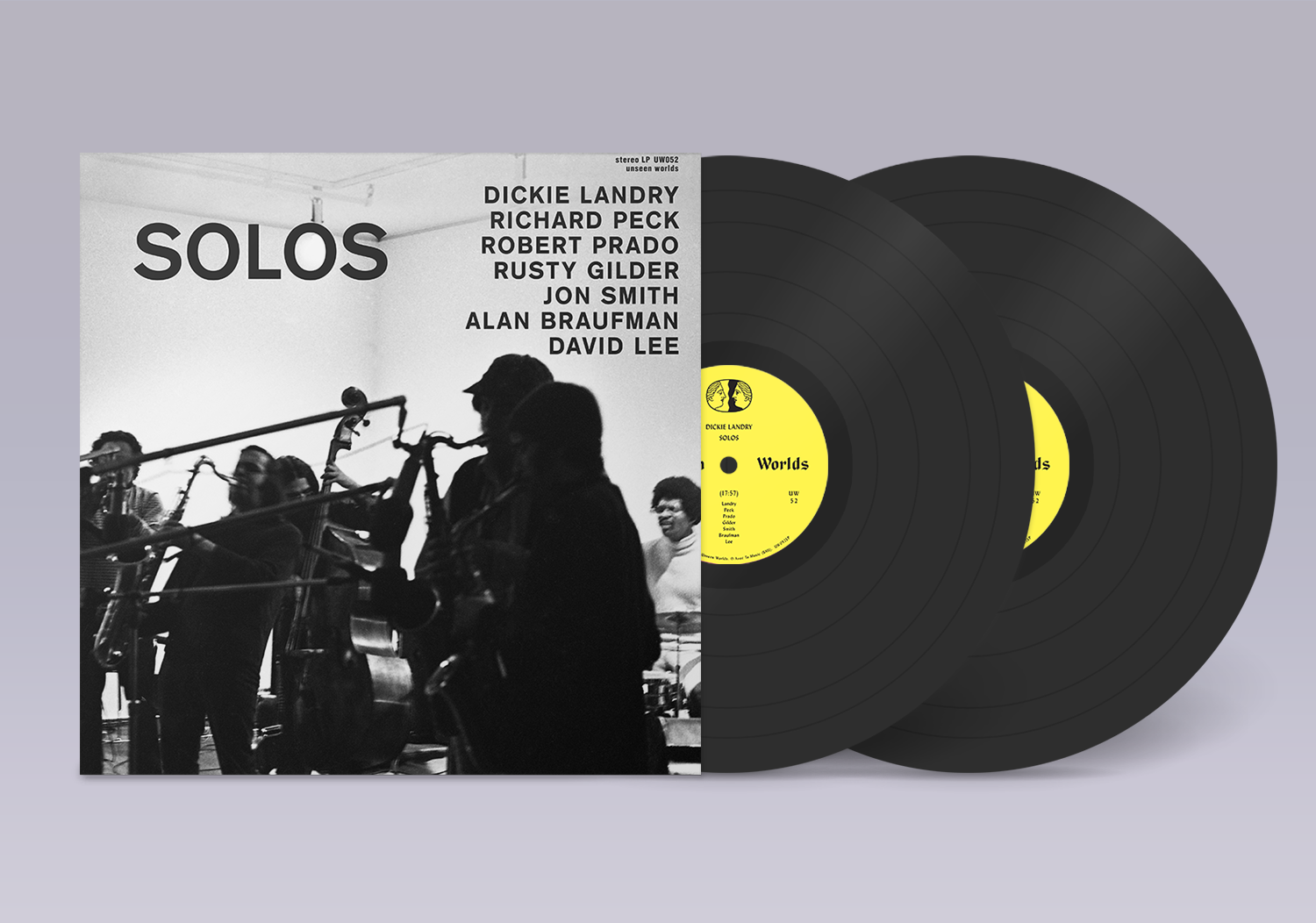
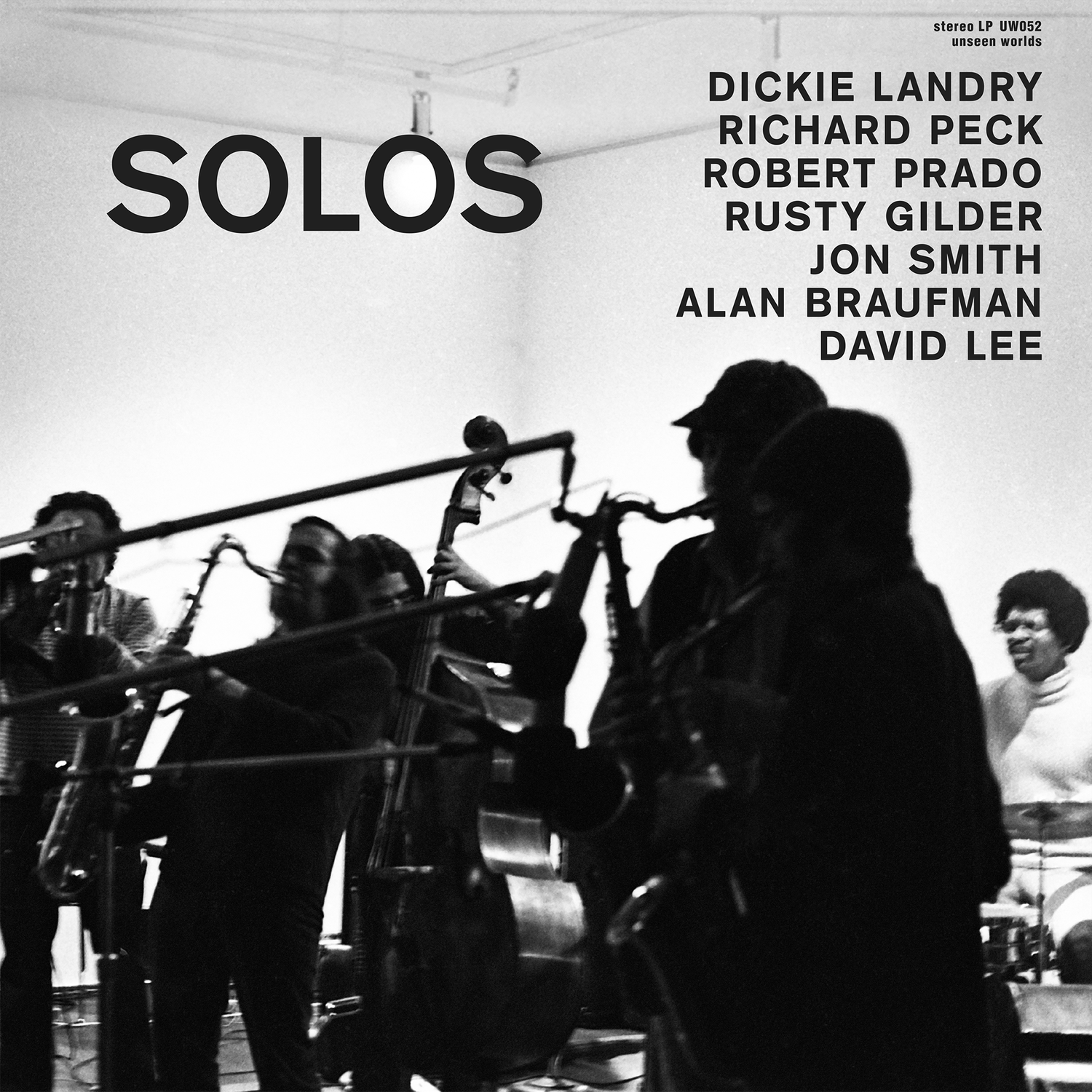
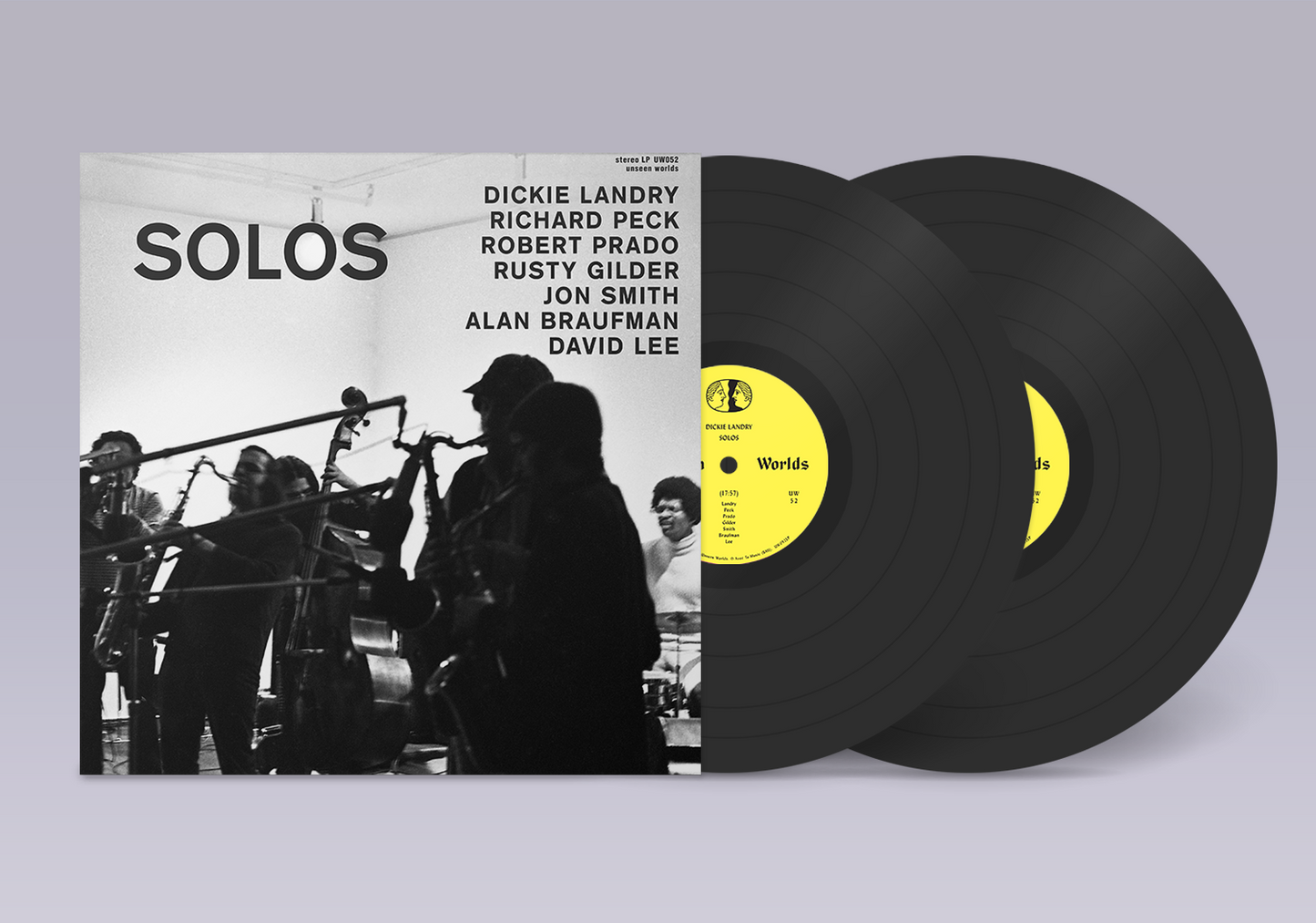
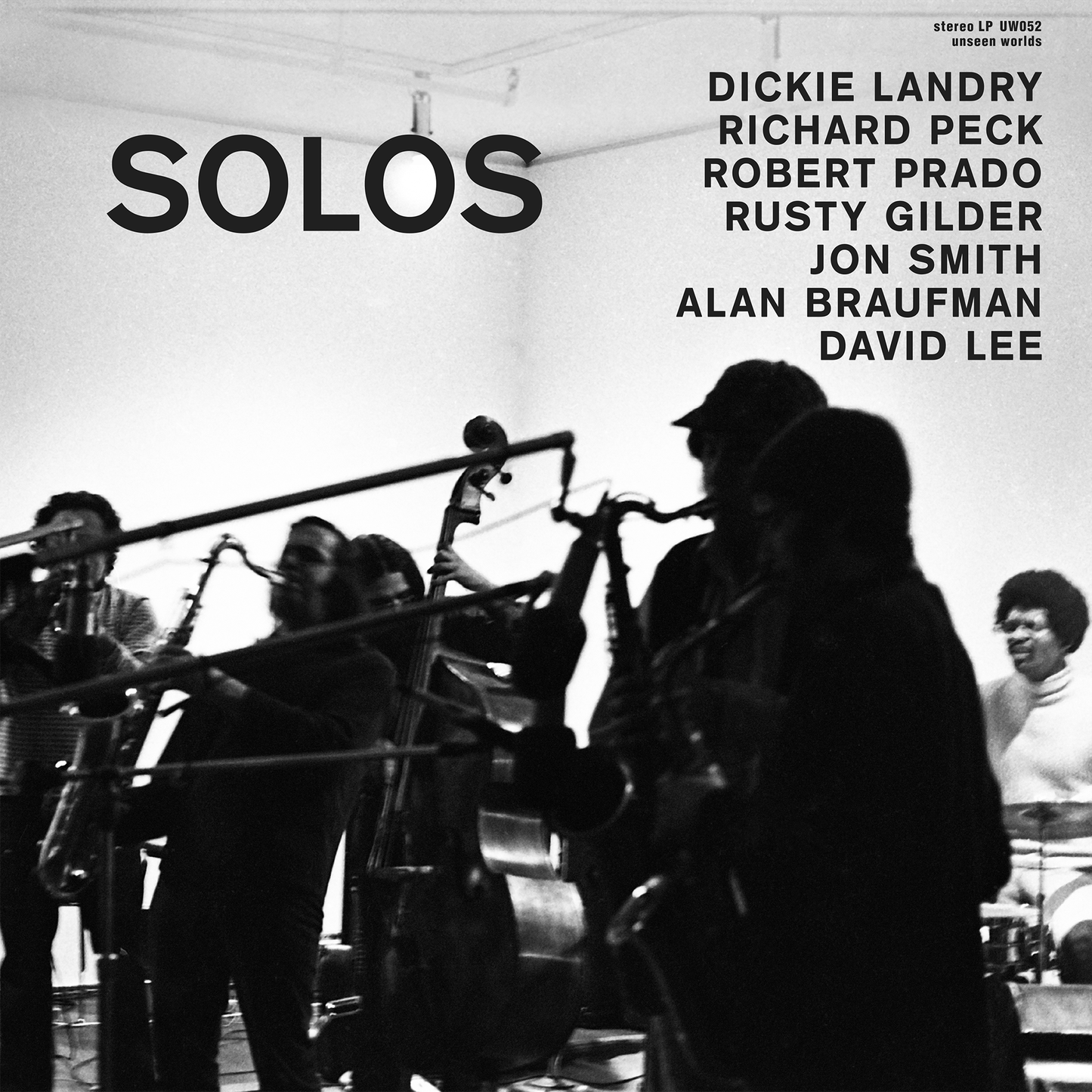
![[product title] - unseen worlds](http://unseenworlds.com/cdn/shop/products/UW06CoverHiRes_533x.jpg?v=1566370081)
